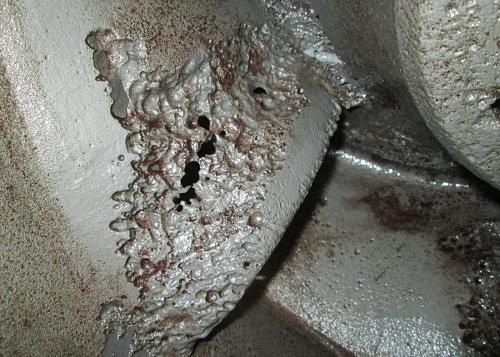Types of Cavitation: Suction and Discharge
The two types of cavitation are suction cavitation and discharge cavitation.
Suction Cavitation: Suction cavitation occurs when the centrifugal pump is subjected to low pressure or high vacuum conditions. It is characterized by the impeller having multiple pitting, which makes it resemble a sponge.
Some of the possible causes of suction cavitation include:
- The pump running too far right on the pump curve
- Clogged suction pipe
- Poor suction conditions
- High inlet fluid velocity
- Poor pipe design
Discharge Cavitation: Discharge cavitation occurs when the centrifugal pump’s pressure is too high or loses 90% of its efficiency. Under this condition, the fluid cannot easily flow out of the pump. Instead, it moves inside the working chamber at high speeds, causing cavities to form. The easiest way to identify discharge cavitation is to check the impeller for pitting around the outer edges.
Some of the possible causes of discharge cavitation include:
- The pump running too far left (below Minimum Continuous Stable Flow) on the pump curve
- Clogged discharge pipes or filters
- Poor pipework design
How To Prevent Centrifugal Pump Cavitation
- Pump Selection: The most effective way to prevent cavitation is by selecting the right pump for the application. Cavitation is more likely to occur when the pump head falls or as capacity increases. Choosing the correct pump helps you maintain a positive margin of NPSHa to NPSHr. Ensure the pressure at the pump inlet is at least 10% greater than the pump’s NPSHr.
- Remove Bends and Valves: Bends and valves create restrictions in the flow, causing an increase in fluid velocity and a drop in pressure. This drop in pressure can cause the fluid to reach its vapor pressure and form vapor bubbles, which can collapse and cause cavitation. By reducing the number of bends and valves, the fluid flow is smoother and less restricted, leading to a lower fluid velocity and less pressure drop.
- Maintenance: You also need to carry out regular maintenance on the pump to avoid cavitation. Check filters and strainers to see if they are blocked and unclog them. Assess the entire pump system design to ensure the flow rate is at optimum levels.
- Adjust Suction Pipe Length and Diameter: A long suction pipe can cause a significant pressure drop, leading to cavitation. Therefore, reducing the length can decrease the chances of cavitation. The diameter of the suction pipe affects the fluid velocity, and it can increase the likelihood of cavitation if it is too small. Ideally, ensure there is 12cm of straight pipe for every diameter of pump suction.

